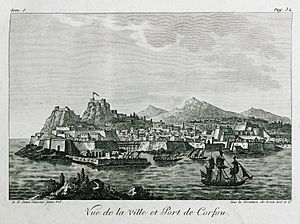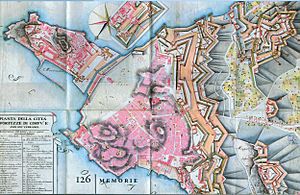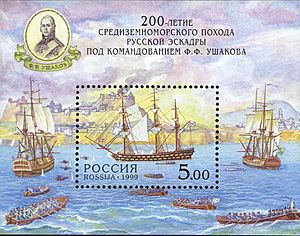Siege of Corfu (1798–1799) facts for kids
Quick facts for kids Siege of Corfu |
|||||||
|---|---|---|---|---|---|---|---|
| Part of the War of the Second Coalition | |||||||
 Corfu city and its fortifications in 1800, engraving by André Grasset de Saint-Sauveur |
|||||||
|
|||||||
| Belligerents | |||||||
| Commanders and leaders | |||||||
| Strength | |||||||
| 6,150 12 ships of the line 11 frigate |
3,500 2 ships of the line 1 frigate |
||||||
| Casualties and losses | |||||||
| 298 killed or wounded |
600 killed or wounded 1 ship of the line, 1 frigate, 1 aviso, 1 bomb ketch, 2 brigantines, 6 galleys, 1 canonnière, and 3 merchant ships captured 636 guns and mortars captured |
||||||
The Siege of Corfu was a big military event that happened between November 1798 and March 1799. It involved a combined fleet from Russia and the Ottoman Empire (Turkey). They fought against French soldiers who were controlling the island of Corfu. This siege was part of a larger conflict called the War of the Second Coalition.
Contents
Why Corfu Was Important
After the Republic of Venice broke apart in 1797, the Ionian Islands were given to France. France then took control of Corfu, making it a French area.
In 1798, a Russian admiral named Fyodor Ushakov was sent to the Mediterranean Sea. He led a combined Russian and Turkish fleet. Their main goal was to take the important Ionian Islands from the French. These islands were very important for controlling the sea.
Before Corfu, the French had already been forced out of other islands like Cythera, Zakynthos, Cephalonia, and Lefkada. Corfu was the biggest and strongest island left.
French Defenses on Corfu
The city of Corfu is on the east side of the island. It was protected by two main forts:
- The Old Fortress: This was a medieval fort on the eastern tip of the city. A man-made ditch separated it from the rest of the city.
- The New Fortress: This was a much larger and newer fort. It stood over the northeastern part of the city.
A tall wall connected the new and old forts along the coast. The city also had defenses on two mountains, Abraham and Salvatore. There was also a fort called San Rocco. From the sea, the island of Vido protected the city. Another smaller island, Lazaretto, also had French defenses.
However, these forts were not in great shape. Many of their cannons were old and couldn't be used. The French also didn't have enough food or supplies. They had to quickly gather food from the local people.
The French troops on Corfu were led by General Louis François Jean Chabot. Many of his soldiers were spread out on other islands. This left only about 1,500 men to defend Corfu itself. These soldiers were a mix of different army groups, sailors, and some local volunteers. The French government on the island asked for 3,000 more soldiers and supplies from Italy. They also took away weapons from the local people, as they weren't sure if they could trust them.
In the harbor, the French had a small fleet. It included two large warships, the Généreux and the Leander. They also had a smaller ship called the Brune and a few other vessels.
The Siege Begins
On November 4, 1798, Admiral Ushakov's Russian and Turkish ships started the siege of Corfu. At first, they didn't have enough soldiers for a big landing. So, they decided to wait for more Turkish troops to arrive.
On the very first day, the French left their defenses on Lazaretto island. The Russians quickly took control of it. On November 13, a small group of Russians landed easily and captured the port of Gouvia. From there, the Russians started setting up cannons and firing at the French forts.
In December, more Russian ships arrived. Now, the combined fleet was very strong. It had 12 large warships, 11 frigates, and many smaller vessels.
On January 26, one of the French warships, the Généreux, managed to escape from the harbor. It sailed away to Ancona.
In February, about 4,000 Ottoman (Turkish) soldiers arrived. With these new troops, the allies decided to attack Vido island. Vido was very important because it protected Corfu city. They planned to use their ships' cannons to attack Vido's shore defenses.
Taking Vido Island
The attack on Vido began early in the morning on February 28, 1799. Several ships fired their cannons at the island for four hours. All five of the French defenses on Vido were destroyed. The French ships Leander and Brune tried to help, but they were damaged. They had to retreat back to the safety of Corfu's forts.
Then, the allied fleet landed over 2,000 soldiers on Vido. After a two-hour battle, the island was captured. Of the 800 French soldiers defending Vido, 200 were killed and 400 were taken prisoner. The French commander of the island was also captured. About 150 French soldiers managed to swim to Corfu. The Russians lost 31 soldiers killed and 100 wounded. The Ottomans lost 180 soldiers killed or wounded.
Capturing Corfu City
With Vido island captured, the allies had a clear path to Corfu city. On March 1, the cannons captured on Vido started firing at the city's forts. Russian cannons on shore and some Russian and Turkish warships also joined the attack. The allied soldiers then stormed and captured the outer forts of San Rocco, San Salvatore, and San Abraham.
On March 2, Admiral Ushakov planned to attack the main forts of Corfu. But that morning, the French sent people to ask for a break in the fighting. On March 3, they officially surrendered.
What Happened Next
The French and Russians agreed to an honorable surrender. This meant the French soldiers were allowed to go back to Toulon, France. The remaining French ships in the harbor were taken by the allies. This included the Leander, which had been captured by the French from the British Royal Navy earlier. The Russians returned the Leander to the British.
Admiral Ushakov was greatly honored for his victory. The Russian Emperor gave him a special award. The Ottoman Sultan also gave him a rare medal, which was usually only given to Muslims.
The capture of Corfu meant that Russia and Turkey now controlled all the Ionian Islands. This was very important for their military and political goals. The islands became a new country called the Seven Islands Republic. It was protected by Russia and Turkey for a few years. Corfu then became a base for the Russian fleet in the Mediterranean Sea. Ushakov's fleet later helped in other battles, like the attack on Naples.
Corfu in Movies
In 1953, a director named Mikhail Romm made a movie about the Russian capture of the Ionian Islands. It was called The Ships Storm the Bastions. This movie was part of a two-part story about Admiral Ushakov's life. It was made by a film studio called Mosfilm.
Sources
- Jervis-White-Jervis, Henry, History of the island of Corfú and of the Republic of the Ionian islands, Colburn, London, 1852
- James, William M., The Naval History of Great Britain during the French Revolutionary Wars and Napoleonic Wars, volume 2, 1797–1799, first published 1822–24, reprinted by Conway Maritime Press, London, 2002




